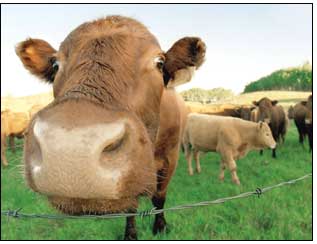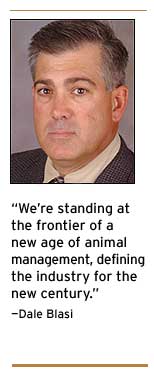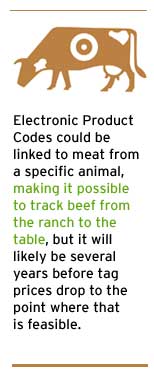Jul 18, 2004By Jonathan Collins
On Dec. 23, 2003, the U.S. government announced that bovine spongiform encephalopathy (BSE) had been found in a six-year-old dairy cow in Mabton, Wash. It was the first case of so-called mad cow disease in the United States, and given that 141 people died in the United Kingdom in the mid-1990s from Creutzfeldt-Jakob disease (CJD), which is transmitted through BSE-infected beef, it’s no surprise that the reaction to the news was swift and painful. More than 50 countries accounting for 95 percent of U.S. beef exports closed their markets to U.S. beef indefinitely. Prices for live U.S. cattle fell from 96 cents per pound to 80 cents within a week of the discovery.
There were also concerns about the long-term impact on the industry. In Europe, beef consumption dropped nearly 30 percent a decade ago after the BSE scare and has never recovered. To prevent that from happening in the United States, the government wanted to take immediate steps to reassure consumers by tracking the history of the infected cow and isolating other animals that might also have the disease to prevent its spread. But that proved more difficult and time consuming than many in the industry would have liked.
It took two weeks for federal officials to complete the DNA tests on the infected dairy cow, which confirmed that it had come from Alberta, Canada. U.S. Department of Agriculture (USDA) officials had to wade through a mound of paper records and other data maintained by breeders and meat packers to trace and recall beef that may have been exposed to tissue from the infected cow. In a bid to prevent the spread of mad cow disease, the USDA ordered the destruction of a herd of nearly 450 Holstein calves, because there was no way to identify which individual animals within the herd were the offspring of the infected animal.
At press time, only 27 of the 80 animals traced back to the infected cow’s original herd in Canada have been found, and although each of those animals tested negative, concern remains that the other animals that have not been traced could enter the food chain. So far, only Poland has lifted the ban on U.S. beef, though Mexico and Canada are accepting some cuts of beef. Prices have climbed back to about 90 cents per pound. But if a person in the United States were to get CJD from eating tainted beef, the consequences for the cattle and beef industry would be catastrophic.
Clearly, there has to be a way to trace diseased animals. RFID has long been used as a means of identifying farm animals and collecting data far more quickly and efficiently than can be done by writing down numbers by hand or scanning a bar code on a plastic or metal tag in an animal’s ear. Many government agencies around the world are in favor of RFID, because it would enable them to link a unique identification number for each animal to a database that includes information specific to that animal, including date of birth, sex and species (see Cattle-Tagging Technology).
But there are many obstacles to deploying RFID in the U.S. cattle industry, including the cost of RFID systems, managing improved data that will change liability for poor-quality or infected cattle, and ensuring that the data collected is secure. The sheer logistics of tagging every head of cattle in the U.S. makes it a huge undertaking. “We’re standing at the frontier of a new age of animal management, defining the industry for the new century,” says Dale A. Blasi, professor and extension beef specialist at Kansas State University. “Essentially, we’re trying to replicate what was done with the U.S. population in the 1930s in creating individual Social Security numbers.”
A National ID Program
The tags cost about $2 to $3 each. A handheld reader is about $400, and fixed dual-panel readers, which are commonly deployed on a restraining chute that animals pass through, can run anywhere from $2,000 to $6,500. But the hardware makes up only part of the cost. Farmers need to transfer the data to a computer or, on a large farm, to a sophisticated back-end system. And then the data needs to be transmitted to a centrally managed database that government officials can use to trace an animal. The middleware needed to make the sharing of data seamless represents a substantial portion of the overall cost of deploying a system.
The costs are beyond the reach of many small ranchers. Nevertheless, there are plans to move toward voluntary use of RFID in the industry. A consortium of livestock producers and processors along with the USDA developed the U.S. Animal Identification Plan for deploying a system of tracking animals across the country with unique identifiers. The aim was to make it possible to track any head of cattle within 48 hours.
The plan, published in September 2003, called for implementation of the system in three phases. The first phase, originally scheduled for implementation in July (year-end looks more likely), requires all U.S. states to have in place a numbering system for identifying cattle ranches and farms (the numbering system could be used to track animals even without the use of RFID).
Funding Is Needed
The second phase requires that, by February 2005, the numbering standard should be able to define individual or groups of cattle for identification in interstate and intrastate commerce. The final phase will see all processing plants, livestock markets and other livestock-industry segments fitted with RFID systems to enable the tracking of animals throughout the supply chain.
Funding for a central database to store information on cattle is supposed to come from both the industry and the U.S. government. But some doubt Washington will come up with the money. “When funding was cut from COOL [country of origin labeling] requirements, how in the world can we believe there will be a quick move to a system to identify an individual cow, as well as the premises, the county and the country it has come from?” says Max Thornsberry Jr., president of the Missouri Stockgrowers Association and owner of Cattle Baron Specialty Meats.
In April, the USDA said it had received $18.8 million to start evaluating the RFID systems that have already been used in trials to see which could scale up and possibly be used for the number-allocation system for premises, as well as for the national database. President Bush has assigned an additional $33 million for the scheme in the 2005 budget. But this is a small percentage of the millions needed to deploy the system nationwide (see table).
Some U.S. states have had success with voluntary RFID cattle-tracking programs. In 2001, Michigan introduced an RFID pilot as part of a plan to eradicate bovine tuberculosis. The state gave tags to beef producers in Michigan’s Lower Peninsula and to those with accredited herds. It also installed RFID readers in three major livestock markets and in five Midwest packing plants, where local producers send their cattle. Thanks to the system, Michigan is able to trace exactly where an animal determined to have tuberculosis was born and other livestock with which it may have had contact.
data and use it to control prices or stifle competition. “The cattle industry is not used to dealing with information, and there’s concern that data could be used to manipulate markets,” says Kansas State’s Blasi.
Cattle producers are also worried that implementing RFID tracking will change accountability when tainted meat enters the food supply. Today, retailers and packers bear the weight of litigation when a recall of beef occurs as a consequence of E. coli, listeria, salmonella or some other outbreak. Many farmers and ranchers are concerned that lawyers would use RFID to trace the meat back to the source and initiate legal action against the producer, even if contamination occurred at the processing plant. Small family farmers would not have the resources to defend themselves.
Many people believe that RFID tagging can bring significant benefits to cattle producers, beyond tracking sick animals, and that these benefits could far outweigh the cost of the systems in the long term. For example, with information available through tagging, farmers could track which animals fetch the best prices and try to increase their margins. Middlemen that purchase cows from many ranchers could track which farms tend to produce cattle that sell for higher prices and thereby focus on their better customers. Small ranchers could also get better information on trends in the market.
In the long term, if prices of Electronic Product Code tags used to track goods in other industries fall dramatically, the tags could be used to track individual cattle from the time of their birth, through the time they are slaughtered and the meat processed, all the way to the supermarket. That would enable the rapid recall of tainted meat and avoid the problem of having to recall all the beef from a supplier to guarantee that affected meat was removed from the food supply. But it will likely be years before EPC tags become cheap enough that they can be used to track individual cuts of beef.
Few doubt that the U.S. government will eventually require ranchers to use RFID to track cattle and other livestock. But widespread adoption won’t happen quickly. If concerns about the cost, security of data and liability are overcome, there is still the issue of cultural resistance to technological change. “Rank-and-file livestock producers are not high-tech gurus,” says Blasi. “We are at the cusp of change in this industry, but some producers look at the industry with nostalgia and think ‘My daddy never did it this way.’”



